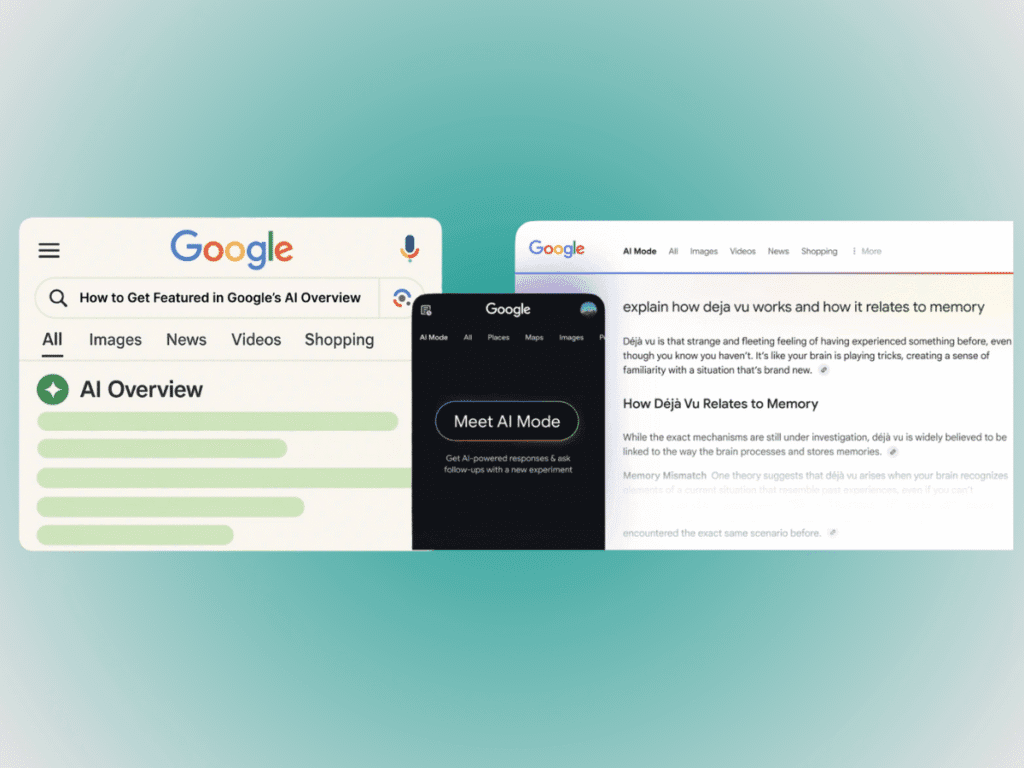The rise of AI-powered search has revolutionized how users interact with search engines and how businesses approach SEO.
Google’s AI Overviews and Gemini’s AI Mode (formerly Bard) are reshaping search behavior with AI-generated summaries, conversational answers, and multi-intent content delivery. If you’re still optimizing for traditional blue links, you’re falling behind.
In this in-depth guide, we’ll explore:
- What AI Overviews and AI Mode are
- How they impact SEO
- How to optimize content to rank in both AI-generated search features
- Practical tips, examples, and strategies to outperform competitors
Whether you’re a marketer, SEO expert, or business owner, this evergreen guide will help you future-proof your SEO for Google’s AI era.
What Are AI Overviews?

Definition
AI Overviews are generative AI-powered summaries that appear at the top of Google’s search results. They answer user queries instantly by aggregating information from multiple high-quality sources.
Where They Appear
- Top of SERPs (Search Engine Result Pages)
- Often above featured snippets and organic listings
- In Google’s AI mode (if enabled)
Example
Search: “How to speed up a slow website?” Google’s AI Overview might display a summarized step-by-step list like:
- Optimize image sizes
- Enable browser caching
- Use a content delivery network (CDN)
These are generated based on top-ranking pages, not just one.
Key Features
- Context-aware answers
- Factual confidence scores
- Citations from reputable sources
- Supports follow-up questions (Gemini integration)
What Is Gemini AI Mode?

Definition
Gemini AI Mode is Google’s conversational AI interface (formerly Bard) integrated into Google Search. When enabled, users get conversational answers, AI summaries, and the ability to ask follow-up questions interactively.
How It Works
- Powered by Gemini 1.5 Pro (as of mid-2025)
- Answers user queries using natural language understanding
- Pulls content from real-time search results, Google Knowledge Graph, and LLMs (Large Language Models)
Key Features
- Conversational and multi-turn search
- Personalized recommendations
- Real-time citations
- Supports visual input (in some cases)
AI Overviews vs. AI Mode: Key Differences
| Feature | AI Overviews | Gemini AI Mode |
|---|---|---|
| Interface | Static SERP block | Conversational UI |
| User Interaction | One-way summary | Interactive, multi-turn |
| Data Sources | Top-ranking pages | Live web + knowledge base |
| Personalization | Limited | High (based on activity) |
| SEO Relevance | Depends on source ranking | Depends on relevance + semantics |
| Appearance | Top of results | Right-side panel or full screen |
| Citation Style | In-line citations | Source URLs below or inline |
Why AI Search Matters for SEO
AI Search Is Changing User Behavior
- 60%+ of queries now trigger AI Overviews in testing markets (US, India)
- Users rely on summary results more than traditional links
- Conversational follow-up queries are becoming the norm
Traditional SEO Isn’t Enough
Ranking on Page 1 doesn’t guarantee visibility in AI Overviews or Gemini. These systems prioritize:
- Semantic relevance (BERT + LLM optimized content)
- Topical authority
- User-friendly formatting (lists, steps, Q&A)
- Originality and accuracy
To stay ahead, you need to optimize for AI understanding, not just for bots.
How to Optimize for AI Overviews and Gemini Mode
1. Understand User Intent Holistically
AI systems interpret intent contextually:
- Informational: How-to, tips, guides
- Navigational: Brand, service names
- Transactional: Pricing, comparisons
Tip: Target blended intent by combining informative, commercial, and trust-building content.
2. Write Like You’re Teaching a Smart Human
- Use natural language and conversational tone
- Break complex ideas into simple sentences
- Define terms (great for beginners)
- Use analogies, real-life examples
3. Use Structured, Snippet-Friendly Formats
AI prefers:
- Numbered/bulleted lists
- Step-by-step guides
- FAQs
- Definition + Explanation format
Example: Query: What is programmatic SEO? Good Format:
Programmatic SEO is the use of automation to generate large volumes of optimized pages based on data. It typically includes:
- Keyword grouping
- Dynamic content generation
- Internal linking automation
4. Cover the Topic Completely
Google’s Helpful Content System and Gemini prioritize topical depth. To achieve this:
- Answer follow-up questions proactively
- Add subtopics and related context
- Use semantic variations (LSI keywords)
- Link to relevant internal blog posts
5. Use Real-Time and Factual Data
AI-generated answers prefer verifiable facts and recent stats. Keep your content:
- Updated regularly
- Cited from trusted sources (without copying)
- Backed by experience (E-E-A-T)
6. Optimize for Conversational Queries
Include:
- Long-tail questions (e.g., “how to rank in AI mode?”)
- Intent-rich phrases (e.g., “best tools for SEO in Gemini”)
- FAQ-style paragraphs
Real-World Optimization Example: GrowingAI Case Study
Background
GrowingAI optimized an article titled “How to Rank in AI-Generated Search Results”.
Tactics Used:
- Included step-by-step guide format
- Used long-form conversational tone
- Embedded FAQs and schema
- Updated citations and real-world examples
Result:
- Ranked in AI Overviews within 3 weeks
- Featured as source in Gemini Mode across India, UK, and Canada
- 3x higher engagement time and +210% organic CTR
AI SEO Best Practices for 2025 and Beyond
✅ Do:
- Focus on topical authority
- Embed FAQ schema + HowTo schema
- Target AI-first user journeys
- Structure for rich results + voice search
- Write for humans first, then AI
❌ Don’t:
- Keyword stuff or over-optimize
- Use outdated SEO tactics (e.g., exact match spam)
- Copy competitors without value-addition
- Ignore AI search engines (Perplexity, Claude, ChatGPT)
Conclusion
AI-powered search isn’t a trend it’s the new standard. By understanding how AI Overviews and Gemini Mode work and optimizing accordingly, you’ll gain visibility across the most powerful digital real estate of our time.
Whether you’re targeting Google, Gemini, or any AI-first engine, content quality, structure, and semantic intent are your biggest assets.
Ready to dominate the AI search future?
👉 Partner with GrowingAI — your AI SEO growth engine.
FAQs
Q1: Is AI Overview available in all countries?
Q2: Can I control if my site is featured in AI Overviews?
Q3: Does Gemini AI Mode replace traditional search?
Q4: What’s more important—ranking in AI Overviews or Gemini?
Q5: How can GrowingAI help?
Stay Updated with Our Latest AI Insights
Subscribe to get fresh blog posts, trends & tools directly to your inbox.














